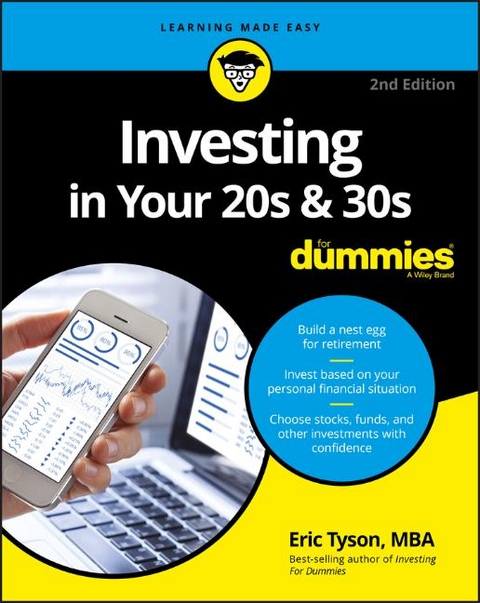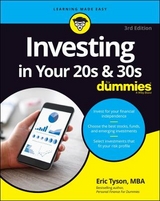
Investing in Your 20s & 30s For Dummies
John Wiley & Sons Inc (Verlag)
978-1-119-43140-4 (ISBN)
- Titel erscheint in neuer Auflage
- Artikel merken
Investing in Your 20s & 30s For Dummies provides emerging professionals, like yourself, with the targeted investment advice that you need to establish your own unique investment style. Covering everything from the latest tax laws to new and improved investing funds, this latest edition helps you evaluate assets and manage risk to invest money wisely, and monitor your progress.
Start building a nest egg for retirement
Invest based on your own financial situation
Understand investment lingo
Have the confidence to manage your money for life
Determine your investment timeline and goals
There's no time like the present to start investing. So, get started today!
Eric Tyson, MBA, is an internationally acclaimed and best-selling personal finance author, counselor, and writer. He is the author of five national best-selling financial books, including Investing For Dummies, Personal Finance For Dummies, and Home Buying Kit For Dummies. He has appeared on NBC's Today Show, ABC, CNBC, FOX News, PBS, and CNN.
Introduction 1
About This Book 1
Foolish Assumptions 2
Icons Used in This Book 2
Beyond the Book 3
Where to Go from Here 3
Part 1: Getting Started with Investing 5
Chapter 1: Making Sense of Your Investing Options 7
Growing Your Money in Ownership Investments 7
Sharing in corporate growth and profits: Stocks 8
Profiting from real estate 8
Succeeding in small business 9
Keeping Money in Lending Investments 9
Understanding Risks and Returns 10
Understanding risks 10
Managing risks 12
Making sense of returns 13
Where to Invest and Get Advice 14
Finding the best fund companies and brokers 14
Finding an acceptable advisor 15
Chapter 2: Using Investments to Accomplish Your Goals 17
Setting and Prioritizing Your Shorter-Term Goals 17
Accumulating a rainy-day fund 18
Saving for large purchases 18
Investing for a small business or home 19
Saving for kids’ educational costs 20
Investing short-term money 20
Investing in Retirement Accounts 20
Understanding retirement account perks 21
Grappling with retirement account concerns 21
Taking advantage of retirement accounts 23
Surveying retirement account choices 23
Selecting retirement account investments 26
Assessing Your Risk-Taking Desires 26
Chapter 3: Setting Your Return Expectations 29
Estimating Your Investments’ Returns 30
Money market funds and savings account returns 30
Bond returns 31
Stock returns 32
Real estate returns 32
Small-business returns 34
Compounding Your Returns 34
The value of getting a few extra percent 34
Considering your goals 36
Chapter 4: Minimizing Your Taxes When Investing 37
Understanding Investment Taxes 38
Tracking taxation of investment distributions 38
Determining your tax bracket 39
Paying attention to the 2017 Congressional tax bill 40
Devising tax-reduction strategies 40
Reducing Your Taxes When Selling Investments 42
Weighing nontax issues 42
Tuning in to tax considerations 43
Part 2: Preparing Your Investing Foundation 47
Chapter 5: Laying Out Your Financial Plans 49
First Priorities: Paying Off High-Cost Debt and Building a Safety Reserve 50
Paying off high-cost consumer debt 50
Establishing an emergency reserve 51
What about Paying Down Other Debts? 52
Assessing student loans 52
Considering paying down mortgage debt 54
Sorting Out Your Financial Plans 54
Considering your investment options and desires 55
Assessing your savings rate 56
Investing regularly with dollar cost averaging 57
Knowing the Impact of Investing for College Costs 58
Paying for college 59
Considering educational savings account options 59
Investing money earmarked for college 61
Securing Proper Insurance 61
Chapter 6: Starting Out with Bank and Credit Union Accounts 63
Understanding FDIC Bank Insurance 64
Investing in Banking Account and Savings Vehicles 64
Bank checking accounts and debit cards 65
Savings accounts and certificates of deposit 66
Negotiating with Bankers 67
Feeling Secure with Your Bank 68
Evaluating any bank 68
Protecting yourself when banking online 69
Exploring Alternatives to Bank Accounts 71
Credit union accounts and benefits 71
Brokerage accounts 72
Money market mutual funds 73
Chapter 7: Managing Money Market Funds 75
Defining Money Market Mutual Funds 75
Making sense of the appeal of money market funds 76
Understanding the drawback of money market funds 77
Understanding Money Market Fund Holdings 78
Protecting and Accessing Your Money in Money Funds 79
Protecting your money 79
Accessing your money 80
Using Money Market Funds in Your Investment Plan 81
Shopping for the Best Money Funds 82
Understanding traits of leading money funds 82
Naming good money funds 83
Alternatives to Money Market Mutual Funds 85
Part 3: Investing in Stocks, Bonds, and Funds 87
Chapter 8: Getting Your Slice of Capitalism with Stocks 89
What Are Stocks? 90
How (And Why) You Can Make Money with Stocks 91
Understanding the importance of corporate profits 91
Making sense of how you profit with stocks 92
Timing Your Stock Buying and Selling 93
Following market indexes 93
Using price/earnings ratios to value stocks 95
Avoiding temptations and hype 96
Getting past the gloom 97
Sidestepping common investing minefields 97
Highlighting How to Invest in Stocks 99
Investing in stock mutual funds and exchange-traded funds 99
Picking your own stocks 100
Maximizing Your Stock Market Returns 103
Chapter 9: Securing Investment Income and Principal with Bonds 105
Defining Bonds 106
Understanding bond issuers 106
Considering credit (default) risk 109
Making sense of bond maturities 109
Using Bonds in a Portfolio 110
Finding uses for bonds 111
Comparing other lending investments with bonds 111
How and Where to Invest in Bonds 115
Choosing between bond funds and individual bonds 115
Investing in Treasury bonds 116
Investing in non-Treasury individual bonds 117
Evaluating individual bonds you currently hold 118
Chapter 10: Investing in Funds: Mutual Funds and Exchange-Traded Funds 119
Understanding the Advantages of Funds 120
Maximizing Your Chances for Fund Investing Success 122
Understanding the importance of performance and risk 122
Examining fund management experience 123
Keeping costs down 123
Understanding and using index funds 124
Understanding exchange-traded funds: Index funds that trade 125
Creating and Managing a Fund Portfolio 126
Identifying the Best Mutual Funds and ETFs 128
Investing in the best ETFs 128
Picking the best stock funds 130
Balancing your act: Funds that combine stocks and bonds 132
Finding the best bond funds 133
Considering Alternatives to Investing in Funds 138
Your own online fund 138
Unit investment trusts 138
Brokerage managed accounts 139
Hedge funds for the wealthier 139
Chapter 11: Understanding Investment Brokers 141
Getting Your Money’s Worth: Discount Brokers 141
Assessing the high-commission salespeople’s arguments 142
Selecting a discount broker 143
Considering Online Brokers 145
Examining your online trading motives 145
Taking other costs into account 146
Looking at service quality 146
Listing the best online brokers 147
Part 4: Investing in Real Estate, Small Business, and Other Investments 149
Chapter 12: Seeking Shelter and Appreciation in Real Estate 151
Comparing Owning a Home to Renting 152
Weighing financial considerations 152
Considering costs and your time frame 153
Deciding when to buy 154
Figuring Your Home-Buying Budget 155
Getting your financial house in order 155
Determining your down payment 155
Doing lenders’ calculations 156
Shopping for Your Home 158
Understanding your housing options 158
Researching communities 160
Checking out and valuing a home 161
Investing in Investment Real Estate 161
Understanding real estate investment’s appeal 162
Sizing up real estate investment options 163
Conducting real estate investing research 167
Chapter 13: Financing and Putting Together Real Estate Investments 169
Financing Your Real Estate Deals 169
Achieving loan approval 170
Debating fixed-rate versus adjustable-rate mortgages 173
Deciding between fixed and adjustable mortgages 174
Finding your best fixed-rate mortgage 176
Landing an appropriate adjustable-rate mortgage 177
Understanding other mortgage fees 180
Finding the best lenders 181
Refinancing for a better deal 183
Working with Real Estate Agents 184
Recognizing agent conflicts of interest 185
Selecting a good agent 186
Putting Your Deal Together 188
Negotiating basics 188
Inspecting the property 189
Shopping for title insurance and escrow services 190
Selling Real Estate 190
Negotiating real estate agents’ contracts 191
Selling without an agent 192
Chapter 14: Taking Your Talents to the Small-Business Arena 193
Investing in Your Career 194
Deciding to Start Your Own Business 195
Weighing your options 195
Entrepreneuring at a company 196
Turning a Business Idea into Reality 196
Drawing up your business plan 196
Plotting to leave your job 199
Financing your business 200
Considering Small-Business Investment Options 202
Buying an existing business 202
Investing in someone else’s business 203
Looking at franchises 204
Beware the pitfalls of multilevel marketing companies 205
Chapter 15: Exploring Other Investment Vehicles 207
Considering Gold and Other Precious Metals 207
Contemplating Collectibles 209
Understanding the allure of collectibles 210
Seeing the realities of collectibles and their returns 210
Considering advice on buying collectibles 213
Understanding Annuities and Cash-Value Life Insurance 214
Availing yourself of annuities 214
Considering cash-value life insurance 214
Part 5: The Part of Tens 217
Chapter 16: Ten Things to Know about Investing Resources 219
Get Educated to Discern the Best from the Rest 219
Beware “Free” 220
Understand the Influence of Advertising 221
Value Quality over Quantity 221
Know How to Check Out a Resource 222
Beware Hype and Exaggeration 223
Don’t Assume Quoted Experts Know Their Stuff 223
Investigate Gurus’ Claims 223
Don’t Believe Investment-Newsletter Claims 224
Check Out and Keep Up with My Favorite Resources 225
Chapter 17: Ten Essential Tips for Investing Success 227
Regularly Save and Invest 5 Percent to 10 Percent of Your Income 227
Understand and Use Your Employee Benefits 228
Thoroughly Research Before You Invest 228
Shun Investments with High Commissions and Expenses 229
Invest the Majority of Your Long-Term Money in Ownership Investments 229
Avoid Making Emotionally Based Financial Decisions 229
Make Investing Decisions Based on Your Plans and Needs 230
Tap Information Sources with High Quality Standards 230
Trust Yourself First 230
Invest in Yourself and Others 231
Chapter 18: Ten Things to Know about Investing Apps 233
Beware of the General Dangers of Putting Apps on Your Cellphone 234
Use Apps Only from Proven Companies with Good Reputations and Longevity 234
Consider the Alternatives to an App 235
Use the Best Personal Finance Apps to Have More to Invest 235
Be Skeptical of Investing Apps Offering “Free” Trading 236
Review Current and Historic Financial and Economic Data 237
Invest with Leading Fund Providers 237
Tap into the Best Investment Brokerage Firms 238
Examine the Best Real Estate Apps 238
Seek out Good Small-Business Apps 238
Personal Finance in Your 20s & 30s 239
Bonus: The Lowdown on Health Insurance 241
Making Sure You’re Covered 242
Transitioning your coverage 242
Seeing how the 2010 healthcare laws (Obamacare) changed your coverage 243
Trumpcare? 244
Finding Your Best Health Plan 245
Selection of doctors and hospitals 245
Plan benefits and features 246
Shopping for Health Insurance 246
Uncovering the best policies 247
Handling insurance rejection 248
Health Savings Accounts: Tax Reduction for Healthcare Costs 249
Index 251
| Erscheinungsdatum | 30.01.2018 |
|---|---|
| Verlagsort | New York |
| Sprache | englisch |
| Maße | 191 x 238 mm |
| Gewicht | 398 g |
| Themenwelt | Sachbuch/Ratgeber ► Beruf / Finanzen / Recht / Wirtschaft ► Geld / Bank / Börse |
| Wirtschaft ► Betriebswirtschaft / Management ► Finanzierung | |
| ISBN-10 | 1-119-43140-9 / 1119431409 |
| ISBN-13 | 978-1-119-43140-4 / 9781119431404 |
| Zustand | Neuware |
| Informationen gemäß Produktsicherheitsverordnung (GPSR) | |
| Haben Sie eine Frage zum Produkt? |
aus dem Bereich



